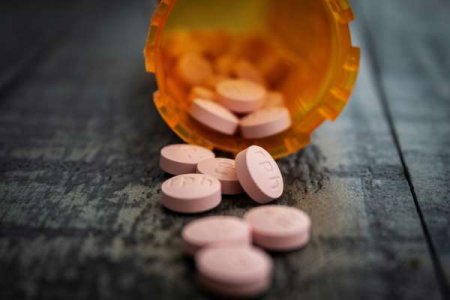One major industry just dodged Trump’s global tariff—Here’s why it matters to you.
- Replies 0
In the ever-shifting landscape of international trade and tariffs, a recent development has emerged that may bring a sigh of relief to many Americans, particularly those concerned about the cost of their medications.
Amidst President Donald Trump's sweeping tariff proposals, which have sent ripples of uncertainty across various industries, certain life-saving products have managed to steer clear of the crosshairs—for the time being.
How does this affect you?
Pharmaceutical companies seem to have sidestepped President Donald Trump's sweeping 10% tariff on most imports, as well as higher rates aimed at select countries.
While outlining his wide-reaching trade proposal, Trump stated that US-based drug manufacturers would either “come 'roaring back'” by ramping up domestic production or they would “have a big tax to pay” for relying on imports.
However, in the executive order released Wednesday after Trump's remarks, the White House clarified that prescription drugs would be excluded from the reciprocal tariffs.
The order also listed exemptions for other key goods, including copper, semiconductors, lumber, certain essential minerals, and various energy products.

Still, the pharmaceutical sector isn’t breathing a full sigh of relief.
Trump has previously floated the idea of introducing trade measures targeting the industry, which has increasingly relied on an international supply chain since the 1990s, spanning continents from Europe to India.
During a conversation with reporters back in February, President Trump indicated that tariffs on imported medications could begin at 25% and potentially go even higher.
The White House press office has yet to respond to inquiries regarding why the pharmaceutical sector was excluded from the tariff list, or if there are future plans to apply industry-specific trade measures.
In earlier news: Experts warn: Trump’s tariffs could drive up drug prices and cause shortages
The pharmaceutical lobbying organization PhRMA expressed support for the administration’s broader goals, aligning with Trump’s aim of boosting domestic production.
“As the president pointed out (Wednesday), our members continue to expand their US footprint, driven in part by tax policies President Trump put in place during his first term,” said Alex Schriver, PhRMA's senior vice president of public affairs.
“We look forward to working with the administration on ways to ensure America remains the most attractive place in the world to discover and manufacture new treatments and cures.”
Possible price hikes for patients
Experts had cautioned before Trump’s latest announcement that broad tariffs on imported medications could lead to increased prescription costs.

They noted that generics and drug ingredients made predominantly overseas would likely see the biggest impact, and those added costs would be passed on to patients.
According to ING Research, a financial firm based in Amsterdam, imposing a 25% tariff on medications and drug ingredients sourced from India and Europe would result in a 17.5% increase in the cost of generic medications.
The extent to which patients would feel the impact varies. For low-cost, commonly prescribed generics—such as those used to treat heart conditions—patients and insurance providers could see an added expense of about $42 annually, ING estimated.
However, the financial burden would be significantly heavier for more complex generics, such as cancer treatments.
Also read: New trade tariffs could spike grocery prices—here’s how to stay ahead
ING projected that a six-month supply of a generic cancer drug could become $8,000 to $10,000 more expensive. These figures are based on the assumption that the added costs from tariffs would be passed down to both insurers and patients.
Diederik Stadig, a senior economist at ING, explained that these price increases for cancer medications were based on the scenario in which the drugs are manufactured in India and exported to the US.
Stadig noted that cancer patients might not feel the effects of the price jump immediately.
Health insurance plans may initially absorb some of the added costs, and delays in price increases could occur due to suppliers having already built up reserves ahead of potential tariffs.
Source: ABC11 / Youtube.
“A lot of people that get treated for cancer, tend to have health insurance, and that means eventually premiums will go up,” Stadig said.
Meanwhile, billionaire and entrepreneur Mark Cuban stated that his company, Cost Plus Drugs, would be forced to raise prices if tariffs were applied to medications imported from India.
Speaking in a podcast interview with Tara Palmeri, Cuban confirmed that his company relies on Indian imports.
“We only have a 15% markup, so we can’t just eat it,” Cuban explained. Given the company’s narrow margins, he said, “we would have to pass those costs along to consumers.”
Tariffs on China, Canada, and Mexico still in force
While pharmaceutical companies have managed to avoid inclusion in the Trump administration's global tariff plan—for now—the previously enacted tariffs on goods from China, Canada, and Mexico remain firmly in place.
Among these is a 20% tariff on imports from China, a country that plays a critical role in supplying generic drug ingredients and medical supplies to the US generic drug manufacturers and hospital pharmacists warn that the added financial burden from these tariffs could create stress on the nation’s supply of generics.
Meanwhile, a separate 25% tariff has been applied to certain imports from Mexico and Canada.
A recent research letter published Monday in the medical journal JAMA revealed that the US currently imports over 400 medications from Canada.
Source: Bloomberg Television / Youtube.
The authors estimated that a 25% tariff on these drugs would cost American consumers an estimated $750 million annually.
Mina Tadrous, a pharmacy professor at the University of Toronto and the study’s lead author, emphasized that such trade policies could have widespread implications.
“Straining this supply chain could trigger drug shortages and jeopardize patient care,” Tadrous said in a news release. “We know that drugs with only one manufacturer and rapidly shifting supply chains increase the risk of shortages.”
Patient advocacy groups have expressed concern that tariff-related price hikes will make medications even more unaffordable for Americans already struggling with prescription costs.
Merith Basey, executive director of Patients For Affordable Drugs Now, voiced her fears that the uncertainty surrounding these trade policies could lead to increased drug prices for patients who are least able to afford them.
“So many Americans have limited savings,” Basey said. “Even what may be perceived as a small increase over a year can be a huge amount for somebody who has a fixed income. Those costs add up.”
Read next: "Liberation Day" shock: Discover the 2 surprising tariffs Trump just unveiled on April 2nd!

Have rising medication costs impacted your household budget in recent years? If so, how have you adapted? Have rising medication costs impacted your household budget in recent years? If so, how have you adapted?
Share your thoughts, experiences, and any strategies you've found helpful in managing prescription drug expenses in the comments below!
Amidst President Donald Trump's sweeping tariff proposals, which have sent ripples of uncertainty across various industries, certain life-saving products have managed to steer clear of the crosshairs—for the time being.
How does this affect you?
Pharmaceutical companies seem to have sidestepped President Donald Trump's sweeping 10% tariff on most imports, as well as higher rates aimed at select countries.
While outlining his wide-reaching trade proposal, Trump stated that US-based drug manufacturers would either “come 'roaring back'” by ramping up domestic production or they would “have a big tax to pay” for relying on imports.
However, in the executive order released Wednesday after Trump's remarks, the White House clarified that prescription drugs would be excluded from the reciprocal tariffs.
The order also listed exemptions for other key goods, including copper, semiconductors, lumber, certain essential minerals, and various energy products.

Prescription drugs were temporarily exempt from President Donald Trump's across-the-board 10% tariff on most imported goods and higher charges for some countries. Image source: James Yarema / Unsplash.
Still, the pharmaceutical sector isn’t breathing a full sigh of relief.
Trump has previously floated the idea of introducing trade measures targeting the industry, which has increasingly relied on an international supply chain since the 1990s, spanning continents from Europe to India.
During a conversation with reporters back in February, President Trump indicated that tariffs on imported medications could begin at 25% and potentially go even higher.
The White House press office has yet to respond to inquiries regarding why the pharmaceutical sector was excluded from the tariff list, or if there are future plans to apply industry-specific trade measures.
In earlier news: Experts warn: Trump’s tariffs could drive up drug prices and cause shortages
The pharmaceutical lobbying organization PhRMA expressed support for the administration’s broader goals, aligning with Trump’s aim of boosting domestic production.
“As the president pointed out (Wednesday), our members continue to expand their US footprint, driven in part by tax policies President Trump put in place during his first term,” said Alex Schriver, PhRMA's senior vice president of public affairs.
“We look forward to working with the administration on ways to ensure America remains the most attractive place in the world to discover and manufacture new treatments and cures.”
Possible price hikes for patients
Experts had cautioned before Trump’s latest announcement that broad tariffs on imported medications could lead to increased prescription costs.

Despite the current exemption, the pharmaceutical industry remains cautious as Trump has previously hinted at potential trade actions specific to the industry. Image source: Christina Victoria Craft / Unsplash.
They noted that generics and drug ingredients made predominantly overseas would likely see the biggest impact, and those added costs would be passed on to patients.
According to ING Research, a financial firm based in Amsterdam, imposing a 25% tariff on medications and drug ingredients sourced from India and Europe would result in a 17.5% increase in the cost of generic medications.
The extent to which patients would feel the impact varies. For low-cost, commonly prescribed generics—such as those used to treat heart conditions—patients and insurance providers could see an added expense of about $42 annually, ING estimated.
However, the financial burden would be significantly heavier for more complex generics, such as cancer treatments.
Also read: New trade tariffs could spike grocery prices—here’s how to stay ahead
ING projected that a six-month supply of a generic cancer drug could become $8,000 to $10,000 more expensive. These figures are based on the assumption that the added costs from tariffs would be passed down to both insurers and patients.
Diederik Stadig, a senior economist at ING, explained that these price increases for cancer medications were based on the scenario in which the drugs are manufactured in India and exported to the US.
Stadig noted that cancer patients might not feel the effects of the price jump immediately.
Health insurance plans may initially absorb some of the added costs, and delays in price increases could occur due to suppliers having already built up reserves ahead of potential tariffs.
Source: ABC11 / Youtube.
“A lot of people that get treated for cancer, tend to have health insurance, and that means eventually premiums will go up,” Stadig said.
Meanwhile, billionaire and entrepreneur Mark Cuban stated that his company, Cost Plus Drugs, would be forced to raise prices if tariffs were applied to medications imported from India.
Speaking in a podcast interview with Tara Palmeri, Cuban confirmed that his company relies on Indian imports.
“We only have a 15% markup, so we can’t just eat it,” Cuban explained. Given the company’s narrow margins, he said, “we would have to pass those costs along to consumers.”
Tariffs on China, Canada, and Mexico still in force
While pharmaceutical companies have managed to avoid inclusion in the Trump administration's global tariff plan—for now—the previously enacted tariffs on goods from China, Canada, and Mexico remain firmly in place.
Among these is a 20% tariff on imports from China, a country that plays a critical role in supplying generic drug ingredients and medical supplies to the US generic drug manufacturers and hospital pharmacists warn that the added financial burden from these tariffs could create stress on the nation’s supply of generics.
Meanwhile, a separate 25% tariff has been applied to certain imports from Mexico and Canada.
A recent research letter published Monday in the medical journal JAMA revealed that the US currently imports over 400 medications from Canada.
Source: Bloomberg Television / Youtube.
The authors estimated that a 25% tariff on these drugs would cost American consumers an estimated $750 million annually.
Mina Tadrous, a pharmacy professor at the University of Toronto and the study’s lead author, emphasized that such trade policies could have widespread implications.
“Straining this supply chain could trigger drug shortages and jeopardize patient care,” Tadrous said in a news release. “We know that drugs with only one manufacturer and rapidly shifting supply chains increase the risk of shortages.”
Patient advocacy groups have expressed concern that tariff-related price hikes will make medications even more unaffordable for Americans already struggling with prescription costs.
Merith Basey, executive director of Patients For Affordable Drugs Now, voiced her fears that the uncertainty surrounding these trade policies could lead to increased drug prices for patients who are least able to afford them.
“So many Americans have limited savings,” Basey said. “Even what may be perceived as a small increase over a year can be a huge amount for somebody who has a fixed income. Those costs add up.”
Read next: "Liberation Day" shock: Discover the 2 surprising tariffs Trump just unveiled on April 2nd!
Key Takeaways
- Prescription drugs were temporarily exempt from President Donald Trump's across-the-board 10% tariff on most imported goods and higher charges for some countries.
- Despite the current exemption, the pharmaceutical industry remains cautious as Trump has previously hinted at potential trade actions specific to the industry.
- Analysts warn that imposing tariffs on drug imports could lead to significant price increases for patients, particularly affecting generic drugs and complex medications for conditions like cancer.
- Tariffs already in place on goods imported from China, Canada, and Mexico continue to apply, potentially affecting the cost and availability of pharmaceutical ingredients and medical supplies in the United States.
Have rising medication costs impacted your household budget in recent years? If so, how have you adapted? Have rising medication costs impacted your household budget in recent years? If so, how have you adapted?
Share your thoughts, experiences, and any strategies you've found helpful in managing prescription drug expenses in the comments below!







